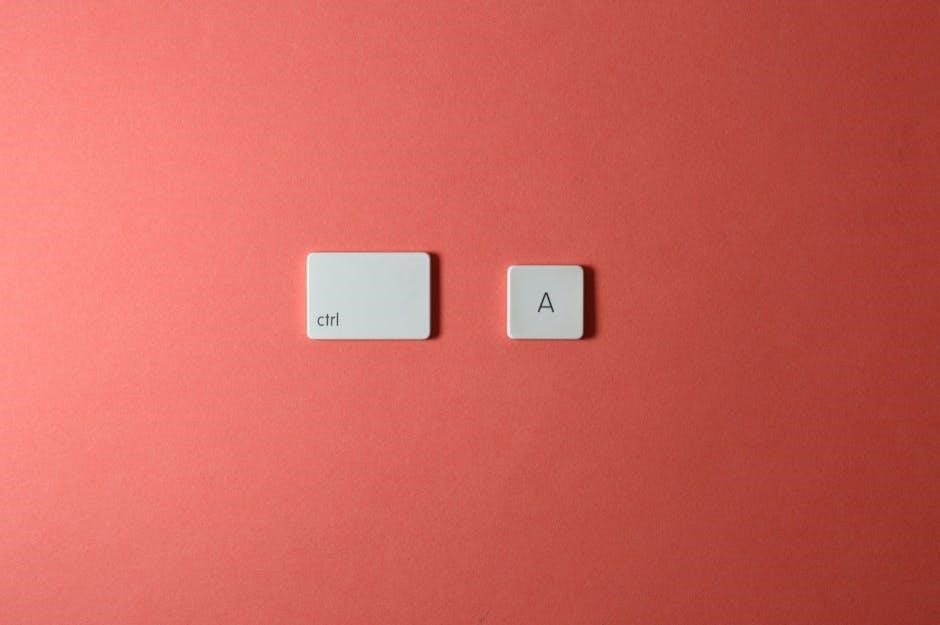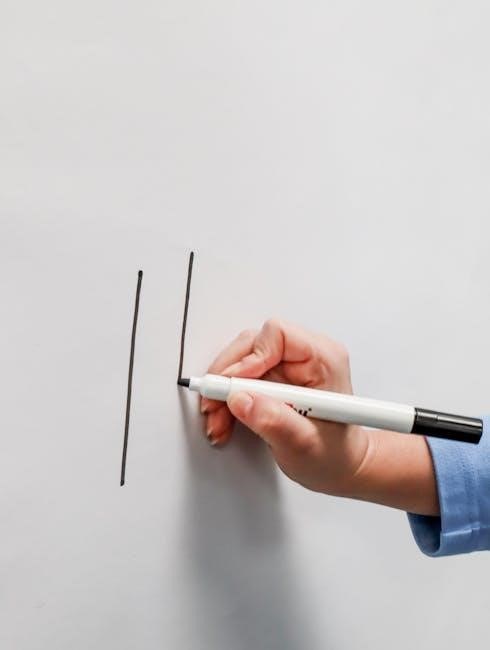Welcome to the Lillebaby Carrier instruction manual! This comprehensive guide helps you master your carrier, ensuring safe, comfortable, and optimal use for you and your baby.
Overview of the Lillebaby Carrier
The Lillebaby Carrier is a versatile, ergonomic baby carrier designed for comfort and convenience. It offers multiple carrying positions, including front-facing in, front-facing out, hip, and back carry, catering to newborns, infants, toddlers, and even pre-schoolers. With its adjustable straps and sturdy waistbelt, it ensures a perfect fit for both caregiver and baby. The carrier is made from durable, high-quality materials and features a sleek design. Its ease of use, combined with safety and comfort, makes it a popular choice for parents seeking a reliable babywearing solution. The manual provides detailed guidance for optimal use.

Importance of Reading the Instruction Manual
Reading the Lillebaby Carrier instruction manual is crucial for safe and effective use. It ensures you understand proper assembly, adjustment, and positioning techniques, preventing potential risks. The manual provides step-by-step guidance tailored for different age groups, from newborns to toddlers, and covers essential safety precautions. By following the instructions, you can maximize comfort and support for both you and your baby, ensuring a secure and enjoyable babywearing experience. Always refer to the manual before first use to familiarize yourself with all features and guidelines. Proper usage enhances safety and satisfaction.
Understanding the Components of the Carrier
The Lillebaby Carrier features adjustable shoulder straps, a waistbelt, and a seat panel designed for ergonomic support. The back panel provides additional structure, while the buckles and straps ensure a secure fit. The carrier also includes a hood for sun protection and privacy. Familiarizing yourself with these components is essential for proper assembly and adjustment. Each part plays a role in ensuring comfort and safety for both wearer and baby. Understanding the carrier’s components will help you use it effectively and make necessary adjustments for optimal support. Regular inspection of these parts is recommended to ensure durability and safety.

Safety Guidelines
Always follow safety guidelines to ensure a secure fit and optimal support. Check for damage before use and adhere to weight recommendations. Proper positioning is crucial.
General Safety Precautions
Always inspect the carrier for damage before use and ensure all straps and buckles are secure. Never leave your baby unattended while using the carrier. Avoid loose clothing that could pose a choking hazard. Ensure proper ventilation to prevent overheating. Keep the carrier away from open flames or hot surfaces. Supervise your baby at all times during use. Avoid activities that could cause the carrier to shift or become unbalanced. Use only authentic Lillebaby parts and accessories. Follow all guidelines in the manual to ensure safe and proper use.
Weight and Age Recommendations
The Lillebaby carrier is designed for babies from 7 to 45 pounds, accommodating newborns to toddlers. Always check the manual for specific weight limits, as models like the Complete and Fundamentals have varying capacities. Ensure proper fit for your baby’s age and size. Newborns require the infant insert for optimal support. As your baby grows, adjust the carrier to maintain ergonomic positioning. Regularly verify weight and age guidelines to ensure safe and comfortable use. Consulting a healthcare professional is recommended for specific needs or concerns.
Understanding Proper Baby Positioning

Proper baby positioning in the Lillebaby carrier ensures your child’s comfort and development. Always maintain an ergonomic “M” shape with knees slightly bent and spine aligned. For newborns, use the infant insert to support their natural curl. As your baby grows, adjust the seat and back panel to accommodate their size. Ensure legs are properly positioned to avoid pressure points. Regularly check the carrier’s fit to promote healthy growth and prevent discomfort. Follow the manual’s guidelines for each age and stage to achieve optimal positioning. Proper alignment is key for both safety and comfort.

Product Overview
The Lillebaby carrier is designed for comfort and durability, offering a versatile babywearing experience. It features an ergonomic design, adjustable settings, and stylish options, ensuring a perfect fit for both parent and baby. With its robust construction and user-friendly features, it supports various carrying positions while maintaining ease of use. The carrier is ideal for daily use, combining functionality, style, and adaptability for different stages of your child’s growth.
Features of the Lillebaby Carrier
The Lillebaby carrier boasts an ergonomic design with adjustable shoulder straps and a wide waistbelt for optimal comfort. It features a sturdy back panel and a wide seat to ensure proper baby positioning. The carrier includes padded leg openings, a removable hood, and adjustable straps for a customizable fit. Durable materials and a sleek design make it both practical and stylish. The Lillebaby carrier supports multiple carrying positions, from newborn to toddler, ensuring long-term usability and versatility for parents. Its thoughtful design prioritizes both comfort and functionality.
Different Models of Lillebaby Carriers
Lillebaby offers a range of carrier models to suit various needs. The Complete is a popular choice, known for its versatility and adjustable features. The All Seasons model includes a breathable mesh panel for temperature regulation. The Pro series features a more structured design with enhanced padding. The Airflow model is lightweight, ideal for warm climates. Additionally, the Embryo is designed for newborns, while the CarryOn accommodates larger children. Each model caters to different preferences, ensuring a perfect fit for every family.
Accessories and Additional Features
Lillebaby carriers come with several accessories to enhance functionality. A toy ring attaches toys, keeping your baby entertained. A drool pad protects the carrier from spit-up. The sleeping hood supports your baby’s head during naps. Additional features include a lumbar support for added comfort and a teething pad for babies to chew on. Optional accessories like storage bags and replacement straps are available. These extras ensure a customizable and comfortable experience for both wearer and baby.

Assembly and Adjustment
Assembling and adjusting the Lillebaby Carrier is straightforward. Start by unpacking all components and familiarizing yourself with the straps and buckles. Adjust the shoulder straps and waistbelt to ensure a snug, comfortable fit. The carrier is designed for easy customization, allowing you to achieve the perfect support for your baby. Always refer to the manual for specific guidance to ensure proper assembly and adjustment.
Unpacking and Initial Setup
Begin by carefully unpacking the Lillebaby Carrier from its packaging. Inspect all components, ensuring no damage or missing parts. Lay the carrier flat, locating the shoulder straps, waistbelt, and seat panel. Familiarize yourself with the buckles and adjustment points. For initial setup, fasten the shoulder straps and waistbelt to create a snug, even base. Adjust the seat panel to the desired height and width, ensuring proper alignment for your baby’s comfort. This step ensures a safe and comfortable fit for both you and your child.
Adjusting Shoulder Straps and Waistbelt
To ensure a proper fit, start by adjusting the shoulder straps. Pull the straps to tighten or loosen them, ensuring they sit comfortably on your shoulders without digging in. Next, fasten the waistbelt securely around your natural waistline, making sure it’s snug but not overly tight. Adjust the belt to distribute the baby’s weight evenly between your shoulders and hips. Fine-tune the straps and belt as needed for optimal comfort and support. Proper adjustment ensures a safe and comfortable carrying experience for both you and your baby.
Setting Up the Seat and Back Panel
Adjust the seat width by pulling the Velcro tabs on the sides to fit your baby’s size. For newborns, keep it narrow, and widen it as your baby grows. The back panel height should be set according to your baby’s size, ensuring their head is above the top edge for visibility. Use the sliding mechanism to raise or lower the panel. Always ensure the seat is firm and the back panel supports your baby’s spine. Proper positioning promotes comfort and safety, allowing your baby to sit upright with good posture.

Using the Carrier
Master front, hip, and back carries by following proper positioning and adjustment techniques. Ensure a snug, secure fit for your baby’s comfort and support.
Front Facing In (Newborn Position)
For newborns, the front-facing in position cradles your baby closely, ensuring comfort and security. Place your baby with legs flexed and arms in or out of the carrier. The seat should support the baby from knee to knee, maintaining a natural “M” shape. Adjust the straps to keep the baby snug against your chest, with their head at or above the top of the carrier for proper breathing. Ensure the back panel is upright to support the baby’s spine. Monitor your baby’s airway and keep the carrier tight for optimal safety and comfort. This position is ideal for bonding and discreet breastfeeding.
Front Facing Out (Toddler Position)
The front-facing out position is designed for curious toddlers (around 6 months and up) who enjoy exploring their surroundings. Ensure the seat is adjusted to a wider setting and the headrest is lowered. Place your toddler facing outward, with legs in a natural “M” shape. Tighten the straps to secure their weight evenly. Keep their back supported and face visible for safety. This position promotes independence while maintaining closeness. Regularly check the fit and adjust as needed to ensure comfort and proper alignment. This position is ideal for older babies who can hold their head up steadily.
Hip Carry (Side Position)
The hip carry, or side position, is ideal for older babies who can sit up unassisted. Place your baby on one hip, with their legs straddling your side. Adjust the carrier so the seat supports their bottom and thighs. Tighten the shoulder straps evenly to distribute weight comfortably. Ensure the baby’s back is straight and their face is visible. This position allows for easy interaction and is great for short outings. Always ensure proper support and alignment to maintain comfort and safety for both you and your baby.
Back Carry
The back carry is suitable for older babies and toddlers who have strong head and neck control. Position the baby high on your back, with their legs spread apart and knees slightly bent. Adjust the shoulder straps to distribute weight evenly, ensuring the waistbelt sits comfortably above your hips. Ensure the baby’s face is visible and their airway is unobstructed. This position is ideal for longer walks or hikes, as it allows for even weight distribution and promotes bonding. Always check the baby’s position for safety and comfort during use.
Fetal Position
The fetal position is designed for newborns, supporting their natural, curved posture. Place the baby in the carrier with their legs tucked in and their face visible. Ensure the baby’s chest rests against your chest for warmth and support. Adjust the seat height to keep the baby’s bottom low, with their knees slightly bent. Regularly check the baby’s position to ensure their airway remains unobstructed. This position is ideal for short periods and transitions to other carries as the baby grows. Always monitor the baby’s comfort and safety during use.
Special Instructions
This section provides tailored advice for different age groups, ensuring safe and comfortable use. Adjustments may vary based on the child’s size and developmental stage.
Using the Carrier with a Newborn
For newborns (0-3 months), ensure the infant insert is used for proper support. The carrier should be in the fetal position, with baby’s legs tucked in and arms close to the body. Adjust the harness snugly to keep the baby secure and high on your chest, with their head easily kissable. Avoid facing your newborn outward until they can hold their head up unassisted. Regularly check the fit and positioning to ensure comfort and safety. Always follow the manual’s guidelines for newborn-specific adjustments and features.
- Use the infant insert for proper support.
- Keep the baby in the fetal position.
- Ensure the baby is high on your chest.
- Avoid outward-facing until head control is achieved.
Using the Carrier with an Infant
When using the Lillebaby carrier with an infant (4-12 months), ensure proper support for their growing body. Adjust the seat width to fit their hips and maintain a comfortable position. For younger infants, the fetal position is recommended, while older infants may transition to the upright position. Always check the fit and positioning to ensure comfort and safety. Monitor your infant’s developmental milestones to determine when to switch positions or adjust settings. Regularly inspect the carrier for proper fit as your baby grows.
- Adjust seat width to fit your infant’s hips.
- Use the fetal position for younger infants.
- Transition to upright position as they grow.
- Monitor developmental milestones for position changes.
- Regularly check the fit for comfort and safety.
Using the Carrier with a Toddler
For toddlers (12+ months), the Lillebaby carrier offers comfort and support during active exploration. Use the front-facing out or back carry positions to encourage curiosity while keeping them secure. Adjust the shoulder straps and waistbelt to distribute weight evenly. Ensure the seat panel is at or above the toddler’s hips for proper support. Regularly check the fit to accommodate their growth and energy levels. This allows for extended use while maintaining comfort and safety for both wearer and child.
- Use front-facing out or back carry positions.
- Adjust straps and waistbelt for weight distribution.
- Ensure seat panel is at or above toddler’s hips.
- Check fit regularly to accommodate growth.
- Supports extended use with comfort and safety.
Using the Carrier for Pre-Schoolers
For pre-schoolers (typically 3–5 years old), the Lillebaby carrier offers a comfortable and secure way to carry older children. Use the back carry position for better weight distribution and visibility. Ensure the child’s legs are in a supported, seated position with knees slightly bent. Check the weight limit (up to 60 lbs) and adjust straps and waistbelt for optimal fit. Regularly verify that all buckles and straps are secure, especially for active children. This ensures safety and comfort during extended use.
- Recommended for children aged 3–5 years.
- Use back carry for optimal support and visibility.
- Ensure proper leg positioning with knees slightly bent.
- Check weight limit (up to 60 lbs).
- Secure all straps and buckles for safety.

Maintenance and Care
Regularly clean the carrier with mild detergent, avoiding harsh chemicals. Store in a cool, dry place to prevent damage. Handle gently to avoid stretching or tearing fabric or straps.
- Hand wash only with mild detergent.
- Avoid machine washing and drying.
- Store in a dry, cool environment.
- Handle straps and buckles with care.
Cleaning the Carrier
Regular cleaning ensures hygiene and longevity. For the Lillebaby carrier, spot clean stains with a damp cloth and mild detergent. For deeper cleaning, hand wash in cold water with a gentle detergent, avoiding harsh chemicals. Rinse thoroughly and air dry away from direct sunlight. Do not machine wash or dry, as this may damage the fabric or structural integrity. Avoid using fabric softeners, as they can reduce the carrier’s breathability and moisture-wicking properties. Clean straps and buckles separately if needed. Always air dry completely before reuse to prevent mildew or odors.
Storage and Handling
Store the Lillebaby carrier in a cool, dry place away from direct sunlight to prevent fading. Avoid folding or creasing the carrier excessively, as this may damage the fabric or structure. Keep it in a protective bag or case to maintain cleanliness and prevent dust buildup. Handle the carrier with care to avoid scratching or tearing. Do not expose it to harsh chemicals or extreme temperatures. For travel, roll the carrier gently and secure it in a sturdy bag to prevent damage. Proper storage ensures the carrier remains in excellent condition for long-term use.
When to Replace Parts
Replace Lillebaby carrier parts when they show signs of wear, such as fraying, holes, or weakened stitching. If buckles or straps become damaged or difficult to fasten, they should be replaced to ensure safety. Check for fabric thinning or discoloration, which may indicate excessive use. If the carrier’s structural integrity is compromised, discontinue use and replace the necessary components. Regularly inspect the waistbelt, shoulder straps, and back panel for damage. Replace parts immediately if safety or durability is at risk. Always use authorized replacement parts to maintain the carrier’s performance and safety standards.

Troubleshooting
Troubleshooting helps resolve common issues with the Lillebaby Carrier. Consult the manual or contact customer support for guidance on addressing specific problems effectively.
Common Issues and Solutions
Common issues with the Lillebaby Carrier include straps being too tight or loose, improper seat positioning, and difficulty adjusting the back panel. Solutions involve tightening or loosening straps for comfort, ensuring the seat fits snugly against the caregiver’s body, and adjusting the back panel to support the child’s spine. If the carrier feels unstable, check the waistbelt and shoulder straps for proper alignment. For persistent problems, consult the manual or contact customer support for assistance. Regular adjustments ensure optimal comfort and safety for both the child and caregiver.
Adjustment Difficulties
Adjustment difficulties with the Lillebaby Carrier often arise from improper strap alignment or tightness. If the shoulder straps feel restrictive, loosen them slightly and reposition for comfort. The waistbelt may require re-centering to ensure even weight distribution. For the back panel, ensure it is fully extended or collapsed based on the child’s size. If straps slip during use, check for proper fastening and tighten as needed. Regularly testing adjustments ensures a secure and comfortable fit for both the child and caregiver.

Comfort and Fit Problems
Comfort and fit issues with the Lillebaby Carrier can occur if the straps or waistbelt are not properly adjusted. Ensure the shoulder straps are snug but not overly tight, and the waistbelt is centered to avoid pressure points. If the carrier feels too tight or restrictive, check the fit guide in the manual. For persistent discomfort, try repositioning the baby or adjusting the back panel height. Consulting the instruction manual or contacting customer support can help resolve ongoing fit-related concerns for optimal comfort and functionality.
Final Tips for Optimal Use
The Lillebaby Carrier offers comfort and versatility for you and your baby. Always follow the manual for proper use and adjustments to ensure safety and enjoyment.
For the best experience with your Lillebaby Carrier, ensure regular adjustments to maintain comfort and support. Always check the manual for updates or new guidance. Practice different carrying positions to adapt to your baby’s growth stages. Monitor the carrier’s condition and replace worn parts promptly. Emphasize proper weight distribution for ergonomic benefits. Explore all features, like adjustable straps and pockets, to enhance convenience. By following these tips, you’ll maximize comfort, safety, and enjoyment for both you and your baby.
Importance of Following the Manual
Adhering to the Lillebaby Carrier manual ensures safety, comfort, and optimal performance. Proper use prevents accidents and guarantees correct positioning for your baby’s developmental needs. The manual provides tailored guidance for different age groups, from newborns to preschoolers, ensuring the carrier evolves with your child. By following instructions, you achieve the best fit and comfort for both wearer and baby. It also helps avoid common issues and extends the carrier’s lifespan. The manual is your key to mastering the carrier’s features and ensuring a secure, enjoyable experience for years to come.